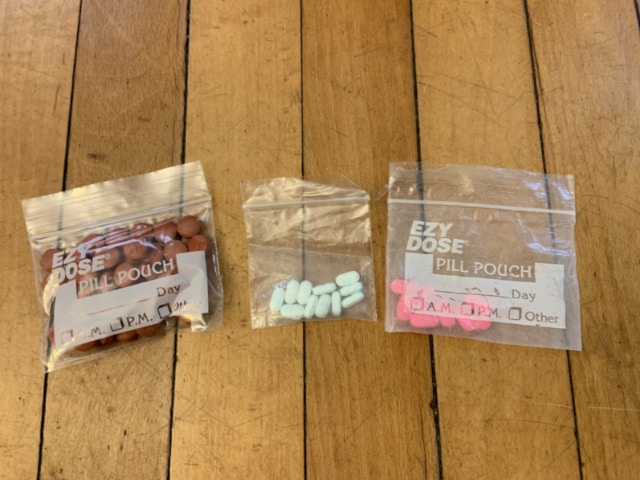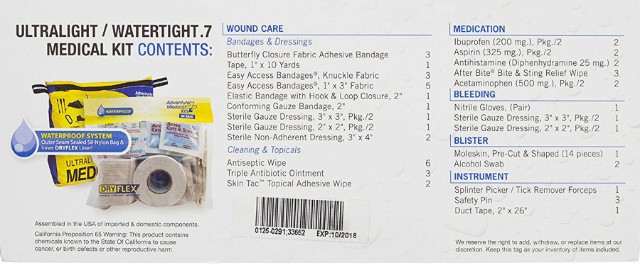I carry a 6-ounce personal first aid kit when I go day hiking and backpacking. It contains more bandages and medications than I might need on a trip so I only have to replenish it periodically. It’s also closely “aligned” to the locale where I do most of my trips, in the Eastern United States where emergency healthcare is usually accessible in a worst-case 24-hour time window, even in rural areas. Different locales will have different first-aid requirements.
I also carry several multi-use items that can augment my first aid kit, which I explain below. My trail clothing system also lets me avoid many issues and ailments associated with ticks, insects, and sun exposure.
Easy-to-Identify Stuff Sack
My first-aid kit is packed in a white stuff sack which makes it easy to find in a backpack and to check whether I’ve packed it.
First Aid Kit Ingredients
Here are the contents of my first-aid kit. I buy everything in quantity and refill things periodically when they run low. You’ll find this approach much less expensive than buying a pre-packaged first aid kit and resupplying it with items sold by the kit’s manufacturer.
All of these items are easy to find over the counter. I rarely use any of it, to be honest and actually give most of these items away to people I hike with or come across in distress.
- Blister prevention: 12 pre-cut Leukotape strips, stuck to release paper
- Blister treatment: 6 Band-aid hydro-skin band-aids of various sizes
- Wound cleaning: 6 alcohol prep wipes
- Small cut care: 6 very sticky Elastoplast bandaids
- Small meds bottle: Personal medical prescriptions, as needed
- Pain and inflammation relief: 10 ibuprofen tablets, 10 Acetaminophen tablets
- Pain and blood thinner in case of heart attack: 12 children’s chewable aspirin pills
- Allergic reaction: 20 Benedryl tablets
- Diarrhea relief: 10 Imodium tablets
- Electrolyte replenishment: 1-2 Tailwind electrolyte drink packets
- Body fluid isolation: Nitrile gloves in case I have to administer first aid to someone else
Multi-Use ingredients, which can be used for first aid if needed
- Wound cleaning, irrigation: Chlorine dioxide water purification drops or tablets
- Scissors: Victorinox Swiss Army Knife Classic
- Chaffing relief: a small container of Zinc Oxide packed in my toilet paper bag
- Chaffing relief: a small container of Vaseline packed in my fire starting kit
Explanation of Ingredients
Leukotape is a very sticky tape that hikers and runners put on their feet to prevent hot spots from forming. The only time I get blisters is when I’m breaking in a new pair of shoes or insoles or I have to do a long road walk. Leukotape comes in a roll which is inconvenient to pack. So I pre-cut it into 3-4″ strips that I stick to mailing label paper (“called release paper”) and carry those instead. This works great, but you have to change the strips once or twice per year because they lose their stickiness over time. Leukotape will typically stay stuck to your feet for two to three days.

Band-aid Hydro Seal Bandages (comparable to Compeed in the UK) are gel-like bandages that help heal blisters and provide cushioning for pain relief. They’re also very sticky and waterproof, so you can shower, keep hiking, etc., while wearing them. They’ll typically stay on for two to four days. They’re the best bandages for blisters I’ve found.
Alcohol Prep Wipes are good to sterilize scrapes, shallow wounds, and blades or scissors before use. The “outdoors” is a pretty dirty place and these wipes are one tool to help prevent infections. They’re often sold in large quantities, like 100 wipe packages.
Elastoplast Plasters are very sticky bandaids that are much stickier than the conventional Band-aids you typically get in the United States. I first discovered them in Scotland, but you can also buy them on Amazon US. They’ll typically stay on for two to three days. They are quite inexpensive, actually.

A 2 oz polyethylene bottle (sold by REI) with a screw-on cap is a good way to package prescription drugs because it prevents the pills from being crushed and is much more space-efficient than carrying a daily pill dispenser. If you lose the cap you can replace it with a plastic soda bottle cap. If you’re paranoid about losing your prescriptions, carry a second bottle with them in some other part of your pack or personal effects. Getting replacement prescriptions in can be an incredible hassle, for instance.
Ibuprofen tablets are quite helpful for pain relief, fever reduction and to reduce inflammation when it is needed. I repackage mine in EZ Dose Ziploc pill bags to keep them dry
Children’s chewable aspirin is good as a blood thinner to prevent clotting if someone is experiencing heart attack symptoms. Chewable tablets can be consumed by anyone. It’s important to check that a patient is not allergic before administering.
Benedryl tablets are good for treating all manner of allergic reactions ranging from bee stings to hayfever. Benedryl is also a good sleep aid that will make you drowsy if you’re having trouble falling asleep. I also repackage mine in pill-sized Ziploc bags to keep them dry.
Acetaminophen tablets (Tylenol). For pain relief, especially for those who cannot take Aspirin & Ibuprofen
Imodium tablets, also called Loperamide, help reduce the symptoms of diarrhea if you consume bad food or water by slowing down your bowel contractions and the movement of food or fluids through your digestive tract. In other words, it plugs you up so nothing comes out. I also repackage mine in pill-sized Ziploc bags to keep them dry.

Tailwind Electrolyte Replacement Packets: Tailwind is an electrolyte replacement mix that contains a mixture of electrolytes including sodium and potassium, and simple sugars so it can be consumed by people who are allergic to the artificial sweeteners found in many other electrolyte mixes. I mainly carry this drink mix for other people to consume when they bonk or feel nauseous because they haven’t been hydrating properly, particularly on hot and humid days.
Nitrile Gloves: One of the most important lessons you learn in Wilderness First Aid is body fluid isolation. You want to avoid coming in contact with an injured person’s blood, sweat, piss, or shit. I help people who I come across from time to time who are in some sort of distress, and wearing Nitrile gloves is a simple way to keep yourself safe if I have to touch them.

Multi-use Ingredients
Aquamira Chlorine Dioxide Water Purification: I carry chlorine dioxide as a backup (to my filter) and as a batch water purification technique on all of my hikes and backpacking trips. Water purified with chlorine dioxide is sterile and can be used to irrigate deep wounds. While it’s painful, scrubbing debris out of wounds helps prevent infection. While you can carry an irrigation syringe for this, a plastic bag, bladder, or hydration hose can also be used to create a stream of water.
Swiss Army Knife Classic: This tiny knife has a small pair of very sharp scissors which are handy for shaping Leukotape or bandages.
Zinc Oxide: Zinc oxide is a soothing cream for treating minor skin irritation including chafing. I carry a small hinged cosmetic jar of it in a plastic bag with my toilet paper. It works wonderfully well to relieve discomfort and prevent further irritation. I go through enough zinc oxide that it pays to buy a big jar and refill my small tub as needed. The refill process is best performed using a nitrile glove to keep the zinc oxide off your hands.
Vaseline: I carry a small tub of vaseline which I smear onto cotton balls as a fire starter. It can be used the same way as zinc oxide although it’s a little greasier. I occasionally use it on my toes under my socks if I feel friction, to prevent blisters.
The Problem with Commercial First Aid Kits
I’ve never been a fan of small commercial first aid kits because they don’t contain the products that I prefer or in enough quantity, necessitating frequent and costly resupply if buy their replenishment kits. I’d rather carry 20 Ibuprofen or Benedryl tablets than the 1 or 2 tablets included in commercial first aid kits because I use them far more often than a commercial kit assumes. If I’m guiding clients, I’ll usually carry a heavier commercial first aid kit, but it contains far more items than you’re likely to ever need on a hike or backpacking trip. Guides carry them to avoid lawsuits as much as to help their clients.

Take a look inside a consumer Adventure Medical Kit sometime. Paying $32.95 for this Ultralight/Watertight .7 Medical Kit is a total rip-off. You can stock a roll-your-own first aid kit that costs less and is just as effective and complete with items in your home medicine cabinet.
Health Maintenance System vs First Aid Kit
The problem with most commercial first aid kits is that they try to package “first aid” as a separate entity so they can sell it and not as an element in a larger gear system. Sure, boo-boos happen, and it’s nice to have enough ingredients to stabilize a patient until you can receive proper medical attention.
But if you’re a serious day hiker or backpacker, I’d encourage you to think about the medical supplies and gear you carry as a larger “health maintenance system” made up of interlocking and multi-use parts. For example, a foam sleeping pad and removable backpack straps can be used to fashion a splint for a broken leg, chlorine dioxide water purification tablets can be used to purify the water used to irrigate wounds, and the hose from a hydration reservoir can be used like an irrigation syringe to wash out wounds. Which is why I view them as part of a larger health maintenance system along with the other gear and supplies that I carry on trips.
Food for thought.
SectionHiker is reader-supported. We only make money if you purchase a product through our affiliate links. Help us continue to test and write unsponsored and independent gear reviews, beginner FAQs, and free hiking guides.
